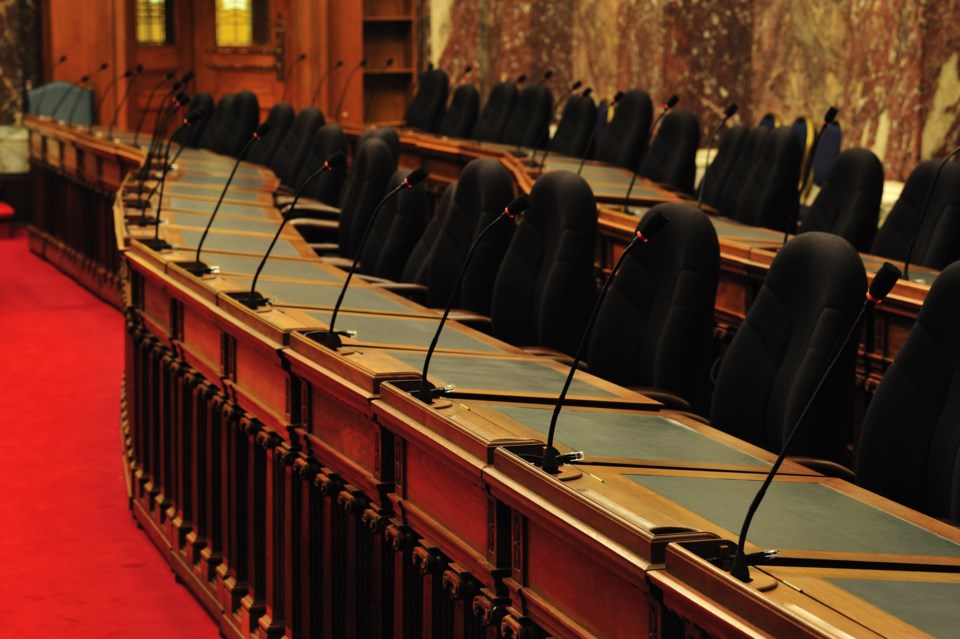Last week, Premier John Horgan announced the house would return “in the coming weeks.” Since then, representatives from all three parties and the Speaker’s Office have been discussing what that could look like.
This won’t be unique. In Alberta, the business of the legislature has gone on – as has partisan politics. In Ottawa, Parliament dipped its toe into holding committee hearings and even Question Period online, with mixed results.
So, what will the old rockpile look like? Not normal. For one thing, a full house would violate Dr. Bonnie Henry’s 50-person ceiling on gatherings, and social distancing would be impossible.
But it also won’t look like when the legislature was recalled for an emergency one-day session in March, with the barest of bare minimum of staff and MLAs to pass a supply bill.
That was done to ensure the government had continued access to money, and didn’t necessarily require extensive debate. The coming session will be different. It’s not clear if government wants or needs to pass new bills, but two things that do need to happen are Question Period and estimates.
You’re probably more familiar with QP, so let’s start with that. As not all MLAs can be in the house at once, some kind of rotation will be necessary. That will change the dynamic for Question Period; you can ask a question of a minister who’s not present, but it’s taken on notice and shelved until they’re back.
Not all MLAs can be in the house at once, some kind of rotation will be necessary.
Ordinarily the opposition doesn’t inform government which ministers they’d like to ask questions, but that may be necessary in June. (The Green Party not only lets the ministers know, but submits the actual question beforehand. It doesn’t often make for great TV.)
What will QP look like? The BC Liberals have started to submit some ideas for economic recovery, and that’s probably where the focus will be. The more interesting thing to watch will be tone.
Unlike Alberta, BC has been remarkable in that partisan sniping has almost entirely been set aside. On Monday, health minister Adrian Dix hosted a townhall with his BC Liberal critic, Norm Letnick. In any other situation, this would be unthinkable.
With QP resuming, the question isn’t whether the tone will go back (down) to normal, but who goes there first, and when – an over-aggressive unfair question, or a snippy non-answer on a difficult file from a minister who just can’t help themselves. (I have my guess – betcha I’m right.)
The question isn’t whether the tone will go back (down) to normal, but who goes there first, and when.
That brings us to estimates. Long the bane of government ministers and staff, “estimates” is shorthand for the process of examining the estimated operational budget for each ministry, including the Premier’s Office, included in the provincial budget each spring.
In estimates, the relevant minister must answer line-by-line questions from opposition critics in real time, accompanied only by a handful of senior staff. Questions can be broad and philosophical but also laser-focus precise – why does the minister need two executive assistants and why did they both receive substantial wages, that sort of thing. This kind of scrutiny is healthy and necessary, and the explicit job of opposition MLAs.
Unfortunately, it also means all of cabinet will need to be in Victoria, at least on rotation, and an equal number of opposition MLAs, again on rotation.
It’s not random, and doesn’t happen all at once. The legislature usually operates two “houses” – the main chamber you see in Question Period, and a committee room. When there’s more business than time, the legislature can and has run three houses simultaneously. This is done sparingly; it’s a major drain on MLA and staff resources. (It’s an order of magnitude harder on opposition than government, so it’s not as rare as it probably should be.)
It will be interesting what happens if a member or minister has to bow out with cold or flu symptoms.
What does that mean? At absolute maximum, the legislature could accommodate three sets of budget estimates at once – but that would mean more MLAs and staff in the building at the same time. And one of the two committee rooms is probably too small to be used right now.
It will be interesting what happens if a member or minister has to bow out with a runny nose, seasonal allergy, or (more ominously) a light fever from a cold. The Premier has emphasized that those with any symptoms must be able to stay home without professional or financial penalty; if (for example) Andrew Wilkinson asks for extra time because he’s not feeling well, Horgan kind of has to accede.
If, as rumoured, the legislature resumes sitting on Monday June 1, and wants to wrap up by Canada Day, that means 16 available days, wrapping up Thursday June 25. (The legislature doesn’t sit on Fridays.) In a pinch, the following week has two more potential sitting days before Canada Day, for a total of 18.
With 21 ministries (again, including the Premier’s Office), that doesn’t leave much time. But since the budget has been effectively out of date for two months, blown out of the water by COVID-19, it may not matter.
Maclean Kay is Editor-in-Chief of The Orca
SWIM ON:
- Maclean Kay also wondered what the one-day emergency sitting would look like.
- Michael Taube wonders what the future holds for Canada's airline industry.
- Is Prince George on the verge of a new boom in a very old industry?



